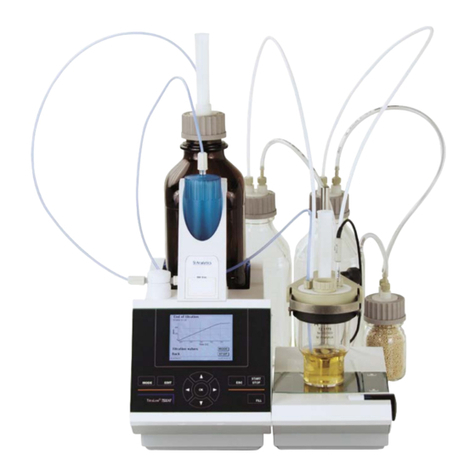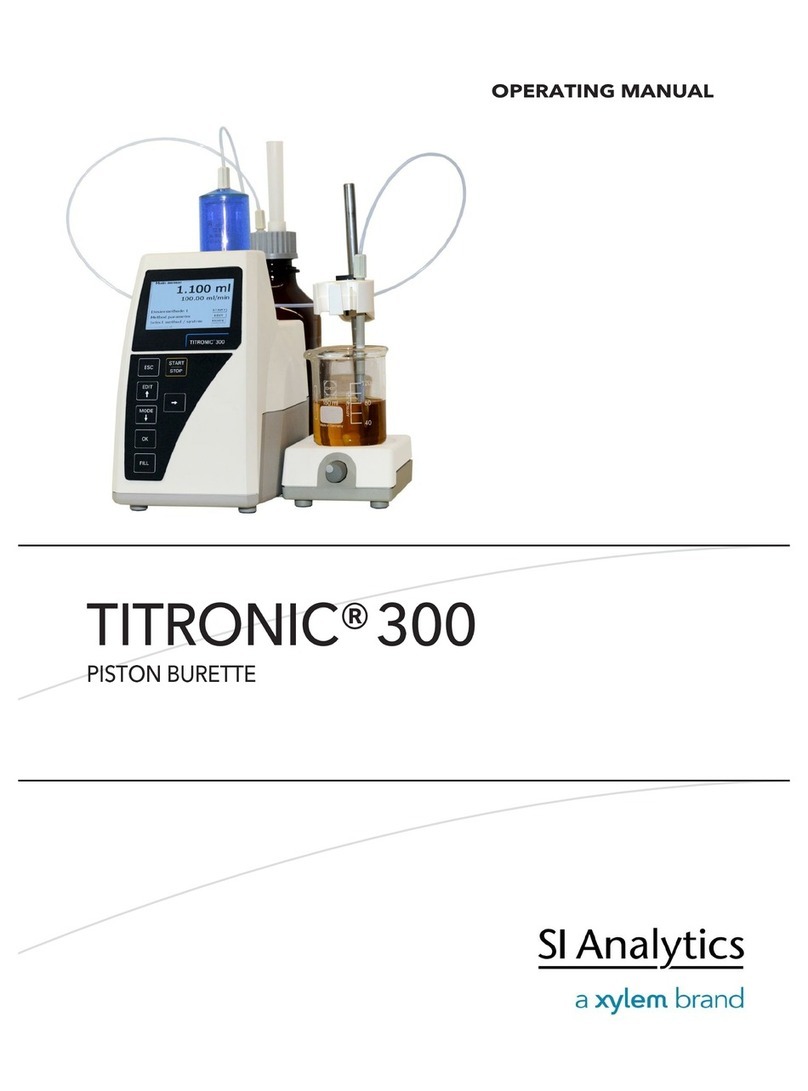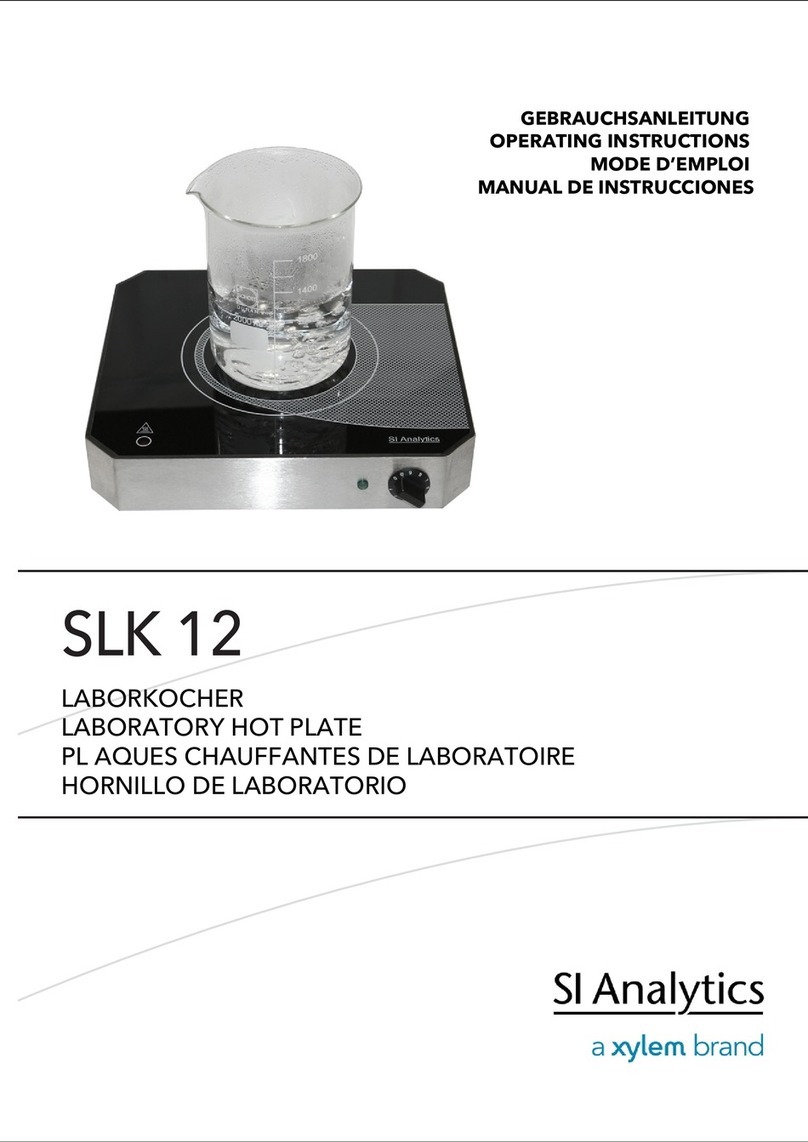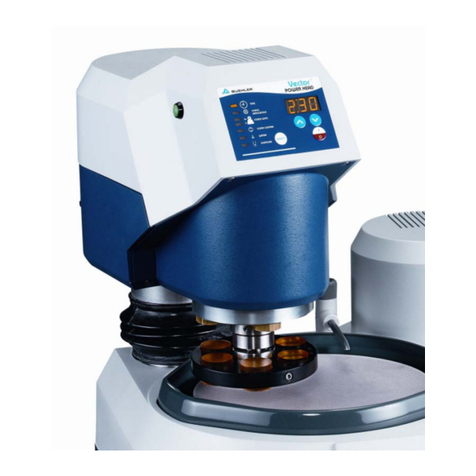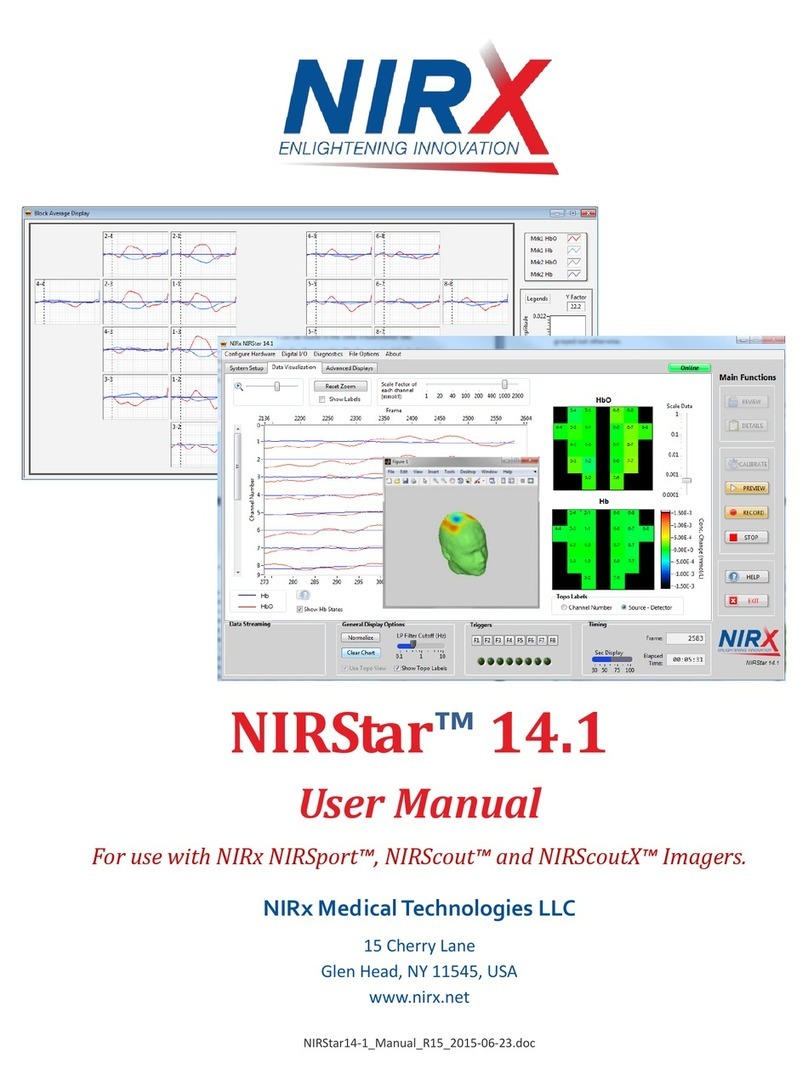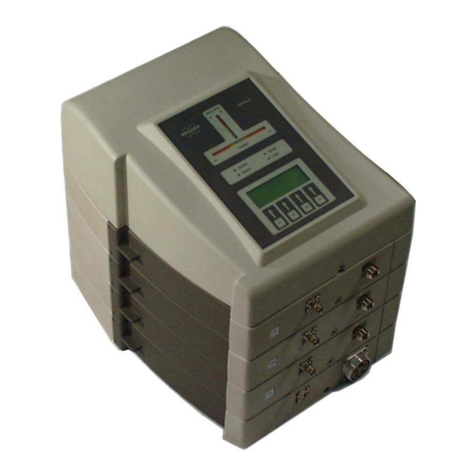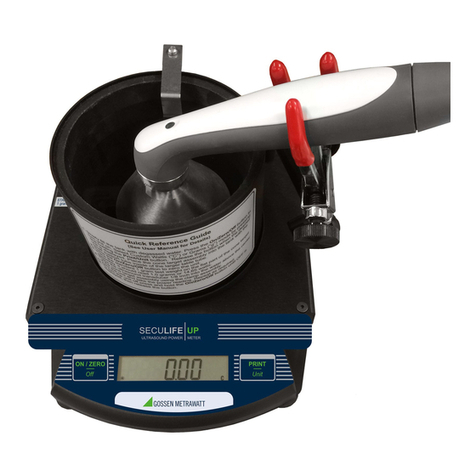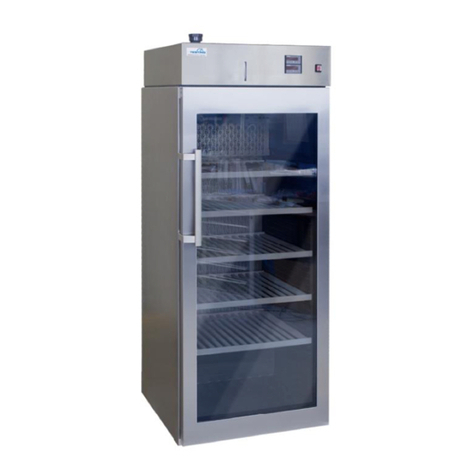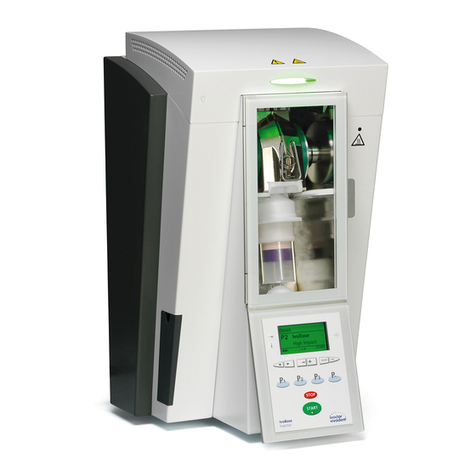SI Analytics TW alpha plus User manual

OPERATING MANUAL
TW alpha plus
TITRATION SAMPLE CHANGER

Gebrauchsanleitung.................................................................................................Seite 3 … 16
Wichtige Hinweise:
Die Gebrauchsanleitung ist Bestandteil des Produktes. Vor der ersten Inbetriebnahme bitte sorgfältig lesen,
beachten und anschließend aufbewahren. Aus Sicherheitsgründen darf das Produkt ausschließlich für die
beschriebenen Zwecke eingesetzt werden. Bitte beachten Sie auch die Gebrauchsanleitungen für eventuell
anzuschließende Geräte.
Alle in dieser Gebrauchsanleitung enthaltenen Angaben sind zum Zeitpunkt der Drucklegung gültige Daten.
Es können jedoch vom Hersteller sowohl aus technischen und kaufmännischen Gründen, als auch aus der
Notwendigkeit heraus, gesetzliche Bestimmungen der verschiedenen Länder zu berücksichtigen, Ergänzun-
gen am Produkt vorgenommen werden, ohne dass die beschriebenen Eigenschaften beeinflusst werden.
Operating Manual .....................................................................................................Page17 … 30
Important notes:
The operating manual is part of the product. Before initial operation, please carefully read and observe the
operating manual and keep it. For safety reasons the product may only be used for the purposes described in
these present operating manual. Please also consider the operating manuals for the devices to be connected.
All specifications in this operating manual are guidance values which are valid at the time of printing. Howev-
er, for technical or commercial reasons or in the necessity to comply with the statuary stipulations of various
countries, the manufacturer may perform additions to the product without changing the described properties.
Mode d’émploi...........................................................................................................Page31 … 44
Instructions importantes:
Le mode d'emploi fait partie du produit. Prière de lire et d’observer attentivement le mode d'emploi avant la
première mise en marche de l´appareil, et de le conserver. Pour des raisons de sécurité, l´appareil ne pourra
être utilisé que pour les usages décrits dans ce présent mode d'emploi. Nous vous prions de respecter éga-
lement les modes d'emploi pour les appareils à connecter.
Toutes les indications comprises dans ce mode d’emploi sont données à titre indicatif au moment de l'impres-
sion. Pour des raisons techniques et/ou commerciales ainsi qu'en raison des dispositions légales existantes
dans les différents pays, le fabricant se réserve le droit d'effectuer des suppléments concernant l´appareil
pour séries de dilution qui n’influencent pas les caractéristiques décrits.
EG – KONFORMITÄTSERKLÄRUNG / EC – DECLARATION OF CONFORMITY
CE – DECLARATION DE CONFORMITE / CEE – DECLARATION DE CONFIRMIDAD

CONTENTS
1Specifications of the TW alpha plus..................................................................19
Intended Use ..........................................................................................................................191.1 Technical specifications..........................................................................................................191.2
2Set-up and initial operation................................................................................20
Unpacking the device.............................................................................................................202.1 Warning and safety information..............................................................................................202.2 Rear view................................................................................................................................212.3 System preparation ................................................................................................................222.4
3Sample plates of the TW alpha plus..................................................................23
4Built-in magnetic stirrer Built-in magnetic stirrer.............................................23
5I/O port of the TW alpha plus Titration Sample Changer.................................23
General I/O description...........................................................................................................235.1 Electrical properties of the I/O port.........................................................................................235.2 Inputs of the I/O port...............................................................................................................245.3 Outputs of the I/O port............................................................................................................245.4 The “Pump-Unit” port..............................................................................................................245.5
6Connection to a computerized titration system ...............................................24
Interface connections .............................................................................................................246.1 Integration in a daisy-chain.....................................................................................................246.2 Data-transfer parameters .......................................................................................................256.3
7Command list of the TW alpha plus Titration Sample Changer......................26
8Switch positions..................................................................................................28
Baud-Rate...............................................................................................................................288.1 Plate size................................................................................................................................298.2 Address...................................................................................................................................298.3
9Guarantee ............................................................................................................30
10 Storage and transportation ................................................................................30
11 Recycling and Disposal......................................................................................30
Version 181114 US

Notes to the Manual
The provided manual will allow you the proper and safe handling of the product. For maximum security,
observe the safety and warning instructions in the operating manual.
Warning of a general danger to personnel and equipment:
Non-compliance results (can result) in injury or material damage.
Important information for device use.
Refers to another part of the operating manual.
Status at time of printing
Advanced technology and the high quality of our products are guaranteed by a continuous development.
This may result in differences between this operating manual and your product. We cannot exclude mis-
takes. We are sure you understand that no legal claims can be derived from the information, illustrations
and descriptions. A potentially more recent version of this manual is available on our internet website.
The German version is the original version and binding in all specifications.
Copyright
© 2018, Xylem Analytics Germany GmbH.
Reprinting - even as excerpts - is only allowed with the explicit written authorization.

19
1 Specifications of the TW alpha plus
Intended Use1.1
Der Titrations-Probenwechsler ermöglicht die Durchführung von Serien-Titrationen mit automatischem
Probenwechsel. Er ist einsetzbar für alle Proben, die in einem offenen Becherglas durchgeführt werden
können. Mit einem dafür geeigneten Titrierkopf lassen sich CSB-Titrationen in den genormten
Reaktionsgefäßen nach DIN 38 409, Teil 41 direkt durchführen. Der Probenwechsler wird über die
RS-232-C-Schnittstellen vom Computer bzw. von Titratoren gesteuert. Er besitzt einen eingebauten
Magnetrührer.
Technical specifications1.2
Translation of the legally binding German version (Release: 08. november 2018)
CE sign: EMC compatibility according to the Council Directive: 2014/35/EU
applied harmonized standards: EN 61 010-1-1:2010
Low-voltage directive according to the Council Directive 2014/30/EU
Testing basis EN 61 326, Part 1
Country of origin:Made in Germany
Automatic TW alpha plus Titration Sample Changer with interchangeable sample plates.
Sample plates for 12, 24 beaker glasses or 24 COD reaction vessels according to DIN 38 409, Part 41.
48-type plates available as special make.
Stroke height:270 mm, at delivery ex-factory limited to 130 mm
Beaker glasses for sample plates with 12 samples Order number
(* = preferred shape):
250 ml with muzzle, low shape 21 106 36*
400 ml with muzzle, high shape 21 116 41
400 ml with muzzle, high shape 21 117 41
Beaker glasses for sample plates with 16 samples Order number
(* = preferred shape):
100 ml with muzzle, low shape 21 106 24
150 ml with muzzle, low shape 21 106 29*
250 ml with muzzle, high shape 21 116 36
250 ml without muzzle, high shape 21 117 36
Beaker glasses for sample plates with 24 samples Order number
(* = preferred shape):
50 ml with muzzle, high shape 21 116 17*
50 ml without muzzle, high shape 21 117 17
Materials:
Device: Casing made of two-component- coated ALU, steel sheet, and epoxy resin
Sample plate: Stainless steel and ABS
Dimensions:
Device: 143 x 620 x 475 mm (W x H x D)
Sample plates: Diameter 450 mm, H = 65 mm (for beaker glasses)
H = 110 mm (for COD reaction vessels according to DIN 38 409, Part 41)
Connection values:
220 V, 30 VA
110 V, 30 VA
Weight
Device: approx. 10.3 kg
Sample plate: with 12 beaker glasses 250 ml: approx 2.7 kg
with 16 beaker glasses 150 ml: approx.2.6 kg
with 24 beaker glasses 50 ml: approx 2.4 kg
with 24 reaction vessels: approx.6.3 kg

20
2 Set-up and initial operation
Unpacking the device2.1
The device was carefully tested and packed in the factory.
For the scope of delivery, please refer to the enclosed part list.
Bitte beachten Sie, dass alle Teile restlos aus der Verpackung entnommen werden.
Please make sure to take out all parts from the packing.
The Sample Changer may be set up on any flat surface.
Please plug the mains connection cable coming with the device to the cold-device plug (Europe-type inte-
grated plug) at the back panel. Before switching on, please ensure that the device’s operating voltage as set
on the voltage-selector switch at the bottom of the device matches the mains voltage. The possible operat-
ing voltage range is shown on the type plate (please refer to the base plate). If the set operating voltage
does not match the mains voltage, please contact your competent service department.
The device is switched on using the mains switch located at the back panel, a green light at the front panel
will indicate the “On” operating status.
Warning and safety information2.2
The device corresponds to protection class II.
It was manufactured and tested according to DIN EN 61 010, Part 1, "Protective Measures for electronic
measurement devices" and control devices and has left the factory in an impeccable condition as concerns
safety technology. In order to maintain this condition and to ensure safe operation, the user should observe
the notes and warning information contained in the present operating instructions. Development and produc-
tion is done within a system which meets the requirements laid down in the DIN EN ISO 9001 standard.
For reasons of safety, the device and the power supply TZ 1853 must be opened by authorised persons
only; this means, for instance, that work on electrical equipment must only be performed by qualified
specialists. In the case of nonobservance of these provisions the device and the power supply may
constitute a danger: electrical accidents of persons or fire hazard. Moreover, in the case of
unauthorised intervention in the device or the power supply, as well as in the case of negligently or deliber-
ately caused damage, the warranty will become void.
Prior to switching the device on it has to be ensured that the operating voltage matches the mains volt-
age. The operating voltage is indicated on the specification plate (Underside of the device and the power
supply). Nonobservance of this provision may result in damage to the device and the power supply,
or in personal injury or damage to property!
If it has to be assumed that safe operation is impossible, the device has to be put out of
operation and secured against inadvertent putting to operation.In this case please switch the device
off, pull plug of the mains cable out of the power supply, and remove the device from the place of work.
Examples for the assumption that a safe operation is no longer possible,
•if the package is damaged,
•if the device shows visible damages,
•if the power supply shows visible damages,
•if the device does not function properly,
•if liquid has penetrated into the casing,
•if the device has been altered technologically or if unauthorized personnel tried or succeeded
to open the instrument as attempt to repair it.
In case that the user operates such a device, all thereof resulting risks are on the user.

21
Rear view2.3
Fig. 1 Rear view of the TW alpha plus Titration Sample Changer
1. Stirrer port (low-voltage integrated plug, inner
contact ∅2.1 mm).
2. Setting of the stirring speed of the built-in
magnetic stirrer
3 Fastening points for hose and cable carriers
4 Setting of sample plate size being used
(section 7.2)
5 Multi-purpose switch for setting the baud rate,
the mains frequency being applied, and the
“normal” or “COD” sample containers being used
(section 7.1)
6 Setting of the device address (section 7.3)
7 Connector for communication with computer
and data communication with titrators, RS-232-C
interface (1) 9-channel D sub miniature socket
(section 5)
8 Connector for data communication with other
peripherals within a daisy chain, RS-232-C inter-
face (2) 9-channel D sub miniature socket
(section 5)
9 Connector for pump and valve modules, 15-
channel D sub miniature socket (section 4)
Moreover, the following operating elements are
accessible from the back panel:
Mains connector with fuse
Pump connector: Rinsing device
Mains switch
1
6
5
2
3
4
7
8
9

22
System preparation2.4
2.4.1 Fitting of a hose carrier
Please use the enclosed knurled screws to attach the hose carrier to the bore holes provided for this pur-
pose on the back panel.
When fastening the hoses and electrode cables afterwards, please avoid any kinking of the hoses and ca-
bles during this process
2.4.2 Changing the stroke height
The ex-factory setting of the stroke height is approx. 130 mm (half of the travel). It is possible to mechanical-
ly change the stroke height using an internal switch. If very high containers are to be used, for instance,
COD containers, the connection of the middle switch is to be interrupted. If the stroke height is to be
modified, the casing has to be opened in any case. To do so, please pull off the titration-head carrier, then
remove the four screws along the front guidance key as well as the two upper and the two lateral ones at
the bottom. After removing the entire enclosure, the middle switch can be found to the left of the guidance
body.
Do not change the setting of the upper limit switch since it is used to limit the travel.
2.4.3 Connection of a titration system
A data cable type TZ 3084 is used to connect the TW alpha plus Titration Sample Changer to a titration
system, or with a type TZ 3088 directly to a computer. This is done using the upper of the 9-channel sockets
on the back panel, i.e. the (1) RS-232-C data communication interface. For further information, please refer
to section 6.
2.4.4 Electrodes, titration tips, stirrer
The required electrodes and titration tips are to be inserted into the corresponding bore holes (NS 14,5) of
the titration head, e.g. of the no. TZ 1463 type. If a stirrer is used, it should also be connected to one of the
bore holes. The power supply of the stirrer is established via a cable which is to be attached to the titration
head and leads to the “Rührer/Stirrer” socket at the back panel of the TW alpha plus Titration Sample
Changer.
The stirring speed can be adjusted by software commands. The max. rps of the built-in magnetic stirrer can
be limited using the potentiometer on the back panel. If you wish that the max. stirring speed be adjustable
through an RS command, the potentiometer is to be set to stage 9.

23
3 Sample plates of the TW alpha plus
Four sample plates are available for the TW alpha plus Titration Sample Changer:
TZ 1452 sample plate: 12 samples 250 ml low shape, 400 ml high shape
TZ 1459 sample plate: 16 samples 100 ml to 150 ml, high and low shape, 250 mm high shape
TZ 1454 sample plate: 24 samples 50 ml, high shape
TZ 1444 sample plate: 24 samples COD reaction vessel according to DIN 38 409, Part 41
Sample plate : 48 samples Available as a special version upon request.
On the back panel of the TW alpha plus Titration Sample Changer there is a stage switch inscribed
“Proben/Samples” (Fig.1, Pos. 4). This switch is used to communicate the sample plates used to the
Sample Changer. Using a small screw driver, this switch can be set to the corresponding size.
Here is: 0 = 12 samples
1 = 16 samples
2 = 24 samples
4 = 48 samples
This setting can also be made via software using the appropriate commands from a connected computer or
titration device (section 7).
The sample plates are set on clock-wise according to the mark engraved on the sample changer. The
connection with the Sample Changer is made by simply placement on the corresponding driving cone. In
this process, the sample plate is to be rotated until it latches. To remove the sample plate, just lift it a little bit
up.
4 Built-in magnetic stirrer Built-in magnetic stirrer
The Sample Changer is equipped with a built-in magnetic stirrer. If the TitroLine®7000, 7750 and 7800 or a
PC Software is used, for instance, this stirrer can be switched on and off via the RS-232-C interface 1.
At the start of titration, the speed set in the method will be transferred. The stirrer will start running at that
speed. When setting the stirring speed, please do not select any setting below 10 seconds.
It the stirring speed is to be controlled by the titration unit, please make sure that the setting knob is set to
full stirring speed, otherwise the max. possible stirring speed will be limited in accordance with the stage set
on the setting knob. The desired stirring speed can then be fine-adjusted using the rotary knob on the back
panel of the sample changer.
5 I/O port of the TW alpha plus Titration Sample Changer
General I/O description5.1
The TW alpha plus Titration Sample Changer is equipped with a 15-channel plug connector for connecting
pump and valve modules. This I/O port can be used to connect the available devices via a cable (Fig. 1,
item. 9). This I/O port is controlled by the computer software. A total of 4 outputs and 5 inputs is available.
For the required commands, please refer to the command list (section 7).
Electrical properties of the I/O port5.2
The in- and outputs of the I/O port are galvanically isolated from the electronics of the titration sample
changer by optocouplers of the HCPL-0700 type. No direct circuiting of power consumers is possible.
The pump and valve modules available from SI Analyticscan be connected directly to the I/O unit using a
cable.

24
Inputs of the I/O port5.3
A maximum current of 20 mA may be applied to the 4 inputs of the I/O port. An optocoupler of the HCPL-
0700 type is being used. Circuiting has to be such that + 5V are applied to the common anode and the in-
puts can be activated by contact to ground. The pin configuration is shown in the list below:
Input Pin number
1 1
2 2
3 3
4 4
Common anode (+ 5 V connection) 13
The statuses of the inputs can be inquired using the “aaIP” command. The answer is: “aaI=10110000”. The
order of the zeroes and ones reflects the logic state of the inputs. The first digit is assigned to the first input.
Only the four first bit are of any relevance; for system reasons, the last 4 bits are always 0.
Outputs of the I/O port5.4
The outputs of the I/O port are configured as follows:
Output Pin number
1 9
2 10
3 11
4 12
Common emitter 14 and 15
Common power supply 13
The supply voltage for the optocoupler outputs has to be made from an external source and amounts to be-
tween 1 and + 18 V. Max. output current of the HCPL-0700 optocoupler module: 60 mA.
The “Pump-Unit” port5.5
This port, located on the back panel the device, is used to control a connected pump (e.g. of the no. TP 20
type) or valve. The built in relay is able to control a voltage of 220 V and a current of 2 A. The <aaCE>
command will switch the port on, the <aaCA> will switch it off again. The <aaCS1..9> command will switch
the port on for the specified time, with the number indicating the time in terms of seconds.
6 Connection to a computerized titration system
Interface connections6.1
The TW alpha plus Titration Sample Changer is equipped with two serial interfaces (RS-232-C) for data
communication with other devices. The plug connectors for these interfaces are located on the back panel
of the device (Fig. 1, item. 7 and 8). The upper socket establishes the connection towards a computer,
whereas the lower socket connects to other devices.
The transfer parameters can be set using the “Baud Rate” switch (Fig. 1, item. 5).
Integration in a daisy-chain6.2
Using a device address will enable you to operate more than one titration devices in the form of a daisy-
chain. Use an RS-232-C cable to connect the computer with the first device in the chain (e.g. with a
TITRONIC®500 plus Piston Burette). Using another cable, connect the second RS-232-C interface of the
burette to the upper RS-232-C interface (1) of the Sample Changer. From the second (lower) RS-232-C
interface (2) of the Sample Changer, it is possible to connect additional devices (Fig. 1, item. 7 and 8).

25
Please make sure that the devices in the chain have different addresses assigned. The device address
of the TW alpha plus Titration Sample Changer can be set on the back panel of the device. The address
range is from 00 to 15, depending on the 0 to F switch position. The “3” address is usually defaulted.
When using the device with a Titrator TitroLine®7000, 7750 or 7800, the sample changer must always
be connected directly downstream of the titration unit.
In this case the RS interface 2 of the last device (Titrator or Piston Burette) is to be set to the 7; 2; no
parameter record. After setting the RS interface, this device must be restarted.
Data-transfer parameters6.3
The transfer speed of the interfaces can be set using the “Baud Rate” switch (Fig. 1, item. 4).
Except for the transfer speed, the following parameters are defaulted:
Number of data bits = 8
Number of stop bits = 1
parity check = even, odd, no
The “Baud Rate” switch can be used to set a total of 2 different speeds:
4800 baud, 9600 baud. The ex-factory setting of the baud rate is 4800.
In addition to the baud rate, this switch can be used to adapt the device to the mains frequency (50 Hz or 60
Hz) and to specify the use of a COD sample plate. The list below shows the details of the switch positions:
Switch Position Meaning
0 4800 Baud / even Parity / 50 Hz / normal beaker glasses
1 4800 Baud / odd Parity / 50 Hz / normal beaker glasses
2 4800 Baud / no Parity / 50 Hz / normal beaker glasses
3 9600 Baud / no Parity / 50 Hz / normal beaker glasses
4 4800 Baud / even Parity / 60 Hz / normal beaker glasses
5 4800 Baud / odd Parity / 60 Hz / normal beaker glasses
6 4800 Baud / no Parity / 60 Hz / normal beaker glasses
7 9600 Baud / no Parity / 60 Hz / normal beaker glasses
8 4800 Baud / even Parity / 50 Hz / COD reaction vessels according to DIN 38 409, Part 41
9 4800 Baud / odd Parity / 50 Hz / COD reaction vessels according to DIN 38 409, Part 41
A 4800 Baud / no Parity / 50 Hz / COD reaction vessels according to DIN 38 409, Part 41
B 9600 Baud / no Parity / 50 Hz / COD reaction vessels according to DIN 38 409, Part 41
C 4800 Baud / even Parity / 60 Hz / COD reaction vessels according to DIN 38 409, Part 41
D 4800 Baud / odd Parity / 60 Hz / COD reaction vessels according to DIN 38 409, Part 41
E 4800 Baud / no Parity / 60 Hz / COD reaction vessels according to DIN 38 409, Part 41
F 9600 Baud / no Parity / 60 Hz / COD reaction vessels according to DIN 38 409, Part 41
When using the TW alpha plus Titration Sample Changer in combination with devices from SI Analytics,
the baud rate is to be set to 4800 including the appropriate options (50 / 60 Hz, normal beaker glasses/COD
reaction vessels).
Extract from the table:
Switch position Meaning
2 4800 Baud / no Parity / 50 Hz / normal beaker glasses
6 4800 Baud / no Parity / 60 Hz / normal beaker glasses
A 4800 Baud / no Parity / 50 Hz / COD reaction vessels according to DIN 38 409, Part 41
E 4800 Baud / no Parity / 60 Hz / COD reaction vessels according to DIN 38 409, Part 41

26
7 Command list of the TW alpha plus Titration Sample Changer
The TW alpha plus Titration Sample Changer features a set of commands which can be used to control it
from connected devices. These commands are generated automatically by titration units from SI Analytics
and the various titration systems. If you wish to create application programs of your own, please use the
commands listed below.
All commands are present in the following form: Address (2 digits) command CR LF.
The address is used to address the proper device, since it is possible that more than one device having an
addressable RS-232-C interface are connected to a computer. The addresses may be selected from 00
through 15. In the list below the addresses are indicated by the generalised “aa” form.
Command Response Reply from the TW alpha plus
aaGT Query of the set plate size aaPlatezz
zz means any digits
aaKH Lift titration head up to upper limit switch aaY
aaKR Lower titration head, aaY
if no beaker glass is present: aaERROR:KEIN BECHER
(NO BEAKER)
aaKGzzz Lower titration head by the specified percentage aaY
of the total travel (zzz = 1 to 100)
aaKUzzz Raise titration head by the specified percentage aaY
of the total travel (zzz = 1 to 100)
aaDV Rotate plate forwards by one position aaY
aaDR Rotate plate backwards by one position aaY
aaDT Move plate to next titration position aaY
(used following the “DCzz” command)
aaDPzz Move plate to the indicated position aaY
(zz = 1 up to max plate position)
aaDCzz Rotate plate to specified position. aaY
The initial position will be stored and serves as information
for the next titration position (-> “aaDT” command)
(zz = 1 to max. plate position)
aaPTNzz Switch plate size to size specified in zz.. aaY
Stroke height for normal beaker height.
(zz = 12; 16; 24; 48)
aaPTCzz Switch plate size to size specified in zz. aaY
Stroke height COD glasses.
aaPO Output of current plate position aaPOSITION= zz

27
Command Response Reply from the TW alpha plus
aaQE The built-in stirrer port and aaY
the built-in stirrer will be switched on
aaQA The built-in stirrer port and aaY
the built-in stirrer will be switched off
aaQSz Setting the stirring speed aaY
(z = 0 bis 9)
aaRH Device identification aaIdent: TW280
aaON witch all 4 outputs on aaY
aaOJ witch all 4 outputs off aaY
aaOE1..4 Switch specified outputs on (1 to 4) aaY
Separate digits by ‘;’, example: aaOE1;3;4
aaOA1..4 Switch specified outputs off (1 to 4) aaY
Separate digits by ‘;’, example: aaOA1;2;3
aaOM1..4 The specified outputs will be monitored by
the inputs specified in the “aaOI” command
Separate digits by ‘;’, example: aaOM2;4
aaOI1..4 The selected outputs will switch off the aaY
inputs specified in the “aaOM” command if
“low” status is present
Separate digits by ‘;’, example: aaOI3;4
aaOT Monitoring of the inputs is switched on. aaY
aaIP Query of all inputs of the I/O port, only the aaI=10110000
4 first digits are relevant
aaWA This command has no effect, but is aakeine Daten
continued for compatibility reasons
aaWO This command has no effect, but is aaY
continued for compatibility reasons
aaVE Query of the built-on software version number aaVersion: MMM TT JJ
aaCA The built-in Pump-Unit port is switched off aaY
aaCE The built-in pump unit is switched on aaY
aaCS1..9 The built-in Pump-Unit port is switched on aaY
for the specified period of time (in s)

28
Command Response Reply from the TW alpha plus
aaRB Check for presence of a beaker glass aaY
if no beaker glass is present: aaERROR:KEIN BECHER
aaRC Repeat last command; however, the last „last command “
command will not be executed again
aaDQ Rotate plate by one position, irrespective of the head position aaY
aaSH Immediate stop of all processes and movements aaY
aaSC Continue all processes and movements
which were stopped with the aaSH command aaY
aaSR Immediate stop of all processes and movements; aaY
all processes and movements are reset to basic state
99AAzz Serial numbering of all devices within the daisy-chain
The first device in the chain will be assigned the zz address. The next
following device will get the zz+1 address.
If zz=15, the next device will be assigned the zz=1 address
All devices respond with their new address zzY
99AB.. Send any command to all devices
all devices will respond to the command specified after <99AB>
Example: 99ABVE will return the version numbers of all connected devices.
8 Switch positions
Baud-Rate8.1
The “Baud Rate” switch (Fig. 1, item. 5) is used to set the transfer speed, the mains frequency, and the
beaker glasses being used. The switch position must only be changed if the TW alpha plus Titration Sample
Changer is switched off. The mains frequency has an effect on the motional speed of the titration head. To
ensure the proper control of the movements of the titration head by the software, the mains frequency has to
be set correctly. The indication of “normal beaker glass”, “COD reaction vessel” has an influence on the
“Lower head” command: Since the COD reaction vessels are considerably higher than normal beaker
glasses, the movement of the titration head has to stop earlier.
Switch position Meaning
0 4800 Baud / even Parity / 50 Hz / normal beaker glasses
1 4800 Baud / odd Parity / 50 Hz / normal beaker glasses
2 4800 Baud / no Parity / 50 Hz / normal beaker glasses
3 9600 Baud / no Parity / 50 Hz / normal beaker glasses
4 4800 Baud / even Parity / 60 Hz / normal beaker glasses
5 4800 Baud / odd Parity / 60 Hz / normal beaker glasses
6 4800 Baud / no Parity / 60 Hz / normal beaker glasses
7 9600 Baud / no Parity / 60 Hz / normal beaker glasses
8 4800 Baud / even Parity / 50 Hz / COD reaction vessels according to DIN 38 409, Part 41
9 4800 Baud / odd Parity / 50 Hz / COD reaction vessels according to DIN 38 409, Part 41
A 4800 Baud / no Parity / 50 Hz / COD reaction vessels according to DIN 38 409, Part 41
B 9600 Baud / no Parity / 50 Hz / COD reaction vessels according to DIN 38 409, Part 41
C 4800 Baud / even Parity / 60 Hz / COD reaction vessels according to DIN 38 409, Part 41
D 4800 Baud / odd Parity / 60 Hz / COD reaction vessels according to DIN 38 409, Part 41
E 4800 Baud / no Parity / 60 Hz / COD reaction vessels according to DIN 38 409, Part 41
F 9600 Baud / no Parity / 60 Hz / COD reaction vessels according to DIN 38 409, Part 41

29
When using the TW alpha plus Titration Sample Changer in combination with the Titrator TitroLine®7000,
7750 or 7800 the baud rate should normally be set to 4800. The list below gives the possible parameters of
the mains frequency and the COD plates:
Switch position Meaning
2 4800 Baud / 50 Hz / normal beaker glasses
6 4800 Baud / 60 Hz / normal beaker glasses
A 4800 Baud / 50 Hz / COD reaction vessels according to DIN 38 409, Part 41
E 4800 Baud / 60 Hz / COD reaction vessels according to DIN 38 409, Part 41
Considering that the position of this switch is only read in during power-up of the device, the sample
changer is to be switched off prior to any change of the switch position, and to be switched on again after
the position of the switch has been changed.
Plate size8.2
The plate size being used is set using the “Proben/Samples” switch (Fig. 1, item. 4) on the back panel of
the TW alpha plus Titration Sample Changer. The switch has 16 positions, of which only the first 4 are in
use. The switch positions have the following meaning:
Position Number of samples
0 12
1 16
2 24
3 48
Considering that the position of this switch is only read in during power-up of the device, the sample
changer is to be switched off prior to any change of the switch position, and to be switched on again after
the position of the switch has been changed
Address8.3
The TW alpha plus Titration Sample Changer is equipped with an addressable serial interface. To make a
clear distinction between all the connected devices, an address is preceding each command. This address
is always made up of 2 digits and stretches in the range from 00 to 15. The address set using a correspond-
ingly marked switch (Fig. 1, item. 6). The switch position correspond to the following addresses:
Position Address
0 00
1 01
2 02
3 03
4 04
5 05
6 06
7 07
8 08
9 09
A 10
B 11
C 12
D 13
E 14
F 15
The “3” address is usually defaulted for operation with the Titrator TitroLine®7000, 7750 or 7800.
Considering that the position of this switch is only read in during power-up of the device, the sample
changer is to be switched off prior to any change of the switch position, and to be switched on again after
the position of the switch has been changed.

30
9 Guarantee
We provide guarantee for the device described for two years from the date of purchase. This guarantee
covers manufacturing faults being discovered within the mentioned period of two years. Claim under guar-
antee covers only the restoration of functionality, not any further claim for damages or financial loss.
Improper handling/use or illegitimate opening of the device results in loss of the guarantee rights. The guar-
antee does not cover wear parts, as lobes, cylinders, valves and pipes including the thread connections and
the titration tips. The breach of glass parts is also excluded. To ascertain the guarantee liability, please
return the instrument and proof of purchase together with the date of purchase freight paid or prepaid.
10 Storage and transportation
If the TW alpha plus Titration Sample Changer has to be stored over some time, or to be dislocated, the use
of the original packing will be the best protection of the devices. However, in many cases this packing will
not be available anymore, so that one will have to compose an equivalent packaging system. Sealing the
lower section in a foil is hereby recommended. The device should be stored in a room with a temperature
between +10 and +40°C, and the (relative) humidity of the air should not exceed 70 %.
11 Recycling and Disposal
Please observe the applicable local or national regulations concerning the disposal of “waste
electrical and electronic equipment”
The TW alpha plus Titration Sample Changer and his packaging are manufactured as far as possible from
materials which can be disposed of environmental-friendly and recycled in a technically appropriate manner.
If you have any question regarding disposal, please contact the service (see backside of this manual).




Typ / type/ type / tipo TW alpha plus
Bescheinigung des Herstellers
Wir bestätigen, dass oben genanntes Gerät gemäß DIN EN ISO 9001, Absatz 8.2.4 „Überwachung und
Messung des Produkts“ geprüft wurde und dass die festgelegten Qualitätsanforderungen an das Produkt
erfüllt werden.
Supplier’s Certificate
We certify that the above equipment has been tested in accordance with DIN EN ISO 9001, Part 8.2.4
"Monitoring and measurement of product" and that the specified quality requirements for the product have
been met.
Certificat du fournisseur
Nous certifions que le produit a été vérifié selon DIN EN ISO 9001, partie 8.2.4 «Surveillance et mesure
du produit» et que les exigences spécifiées pour le produit sont respectées.
Certificado del fabricante
Certificamos que el aparato arriba mencionado ha sido controlado de acuerdo con la norma
DIN EN ISO 9001, sección 8.2.4 «Seguimiento y medición del producto» y que cumple con los requisitos
de calidad fijados para el mismo.
Hersteller
(Manufacturer)
Xylem Analytics Germany GmbH
Dr.-Karl-Slevogt-Str.1
82362 Weilheim
Germany
SI Analytics
Tel. +49(0)6131.66.5111
Fax.+49(0)6131.66.5001
E-Mail: si-analytics@xyleminc.com
www.si-analytics.com
Service und Rücksendungen
(Service and Returns)
Xylem Analytics Germany Sales GmbH & Co.KG
SI Analytics
Gebäude G12, Tor Rheinallee 145
55122 Mainz
Deutschland, Germany
Tel. +49(0)6131.66.5042
Fax.+49(0)6131.66.5105
E-Mail: Service-Instruments.si-analytics@xyleminc.com
SI Analytics is a trademark of Xylem Inc. or one of its subsidiaries.
© 2018 Xylem, Inc. Version 181114 US 602 877 3
Table of contents
Other SI Analytics Laboratory Equipment manuals
Popular Laboratory Equipment manuals by other brands
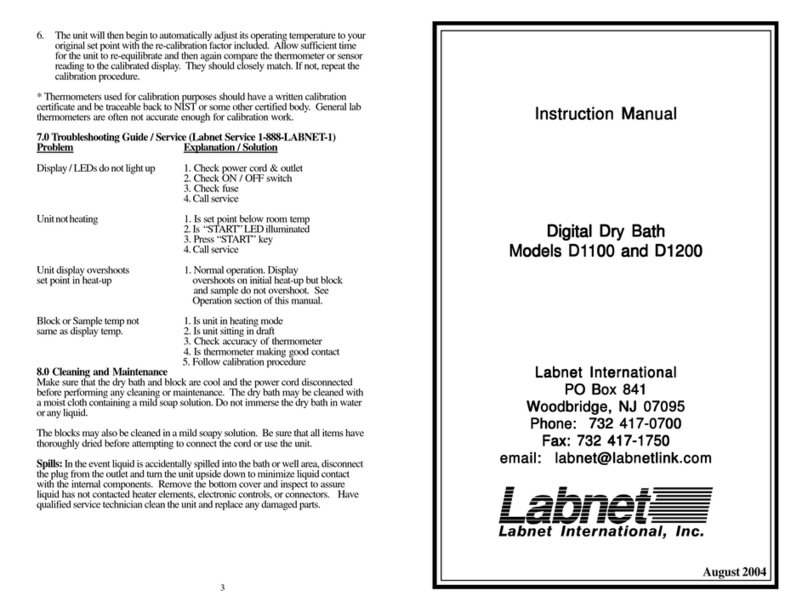
Labnet
Labnet D1200 instruction manual
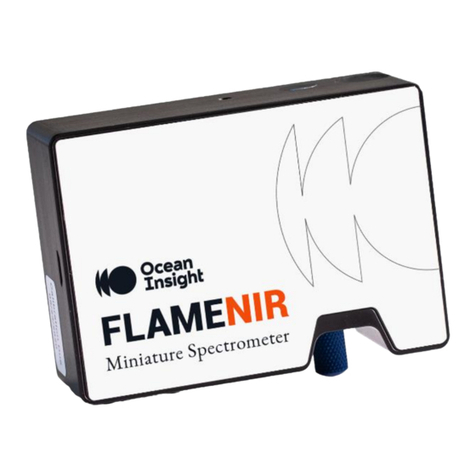
Ocean Insight
Ocean Insight FLAME-NIR+ Installation and operation manual
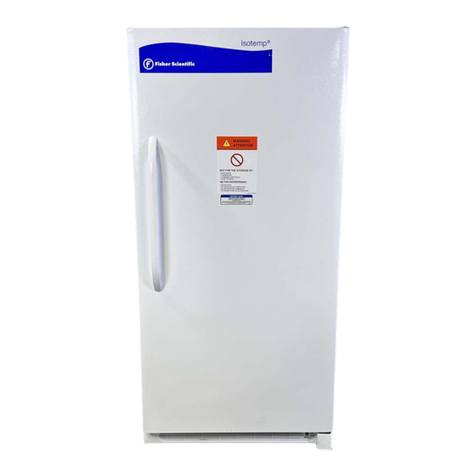
Fisher Scientific
Fisher Scientific Isotemp 20LFEEFSA Instruction and operation manual
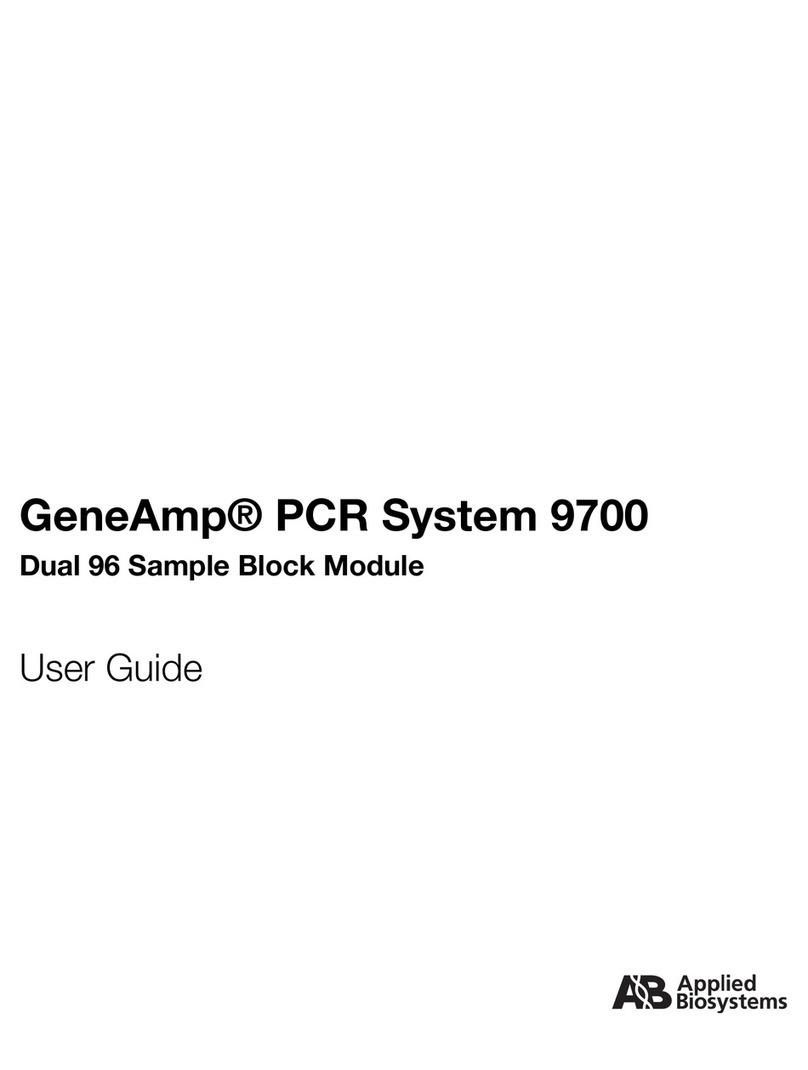
Applied Biosystems
Applied Biosystems GeneAmp PCR System 9700 user guide
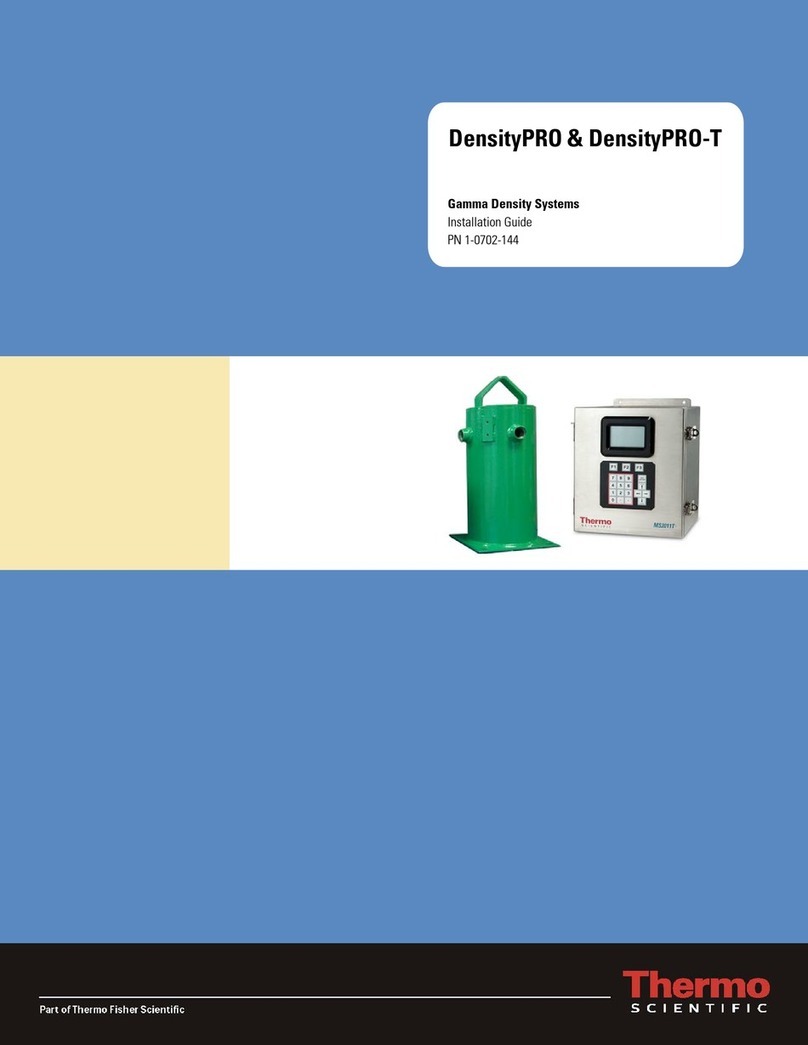
Thermo Scientific
Thermo Scientific DensityPRO-T installation guide

Resodyn
Resodyn LabRAM II user manual
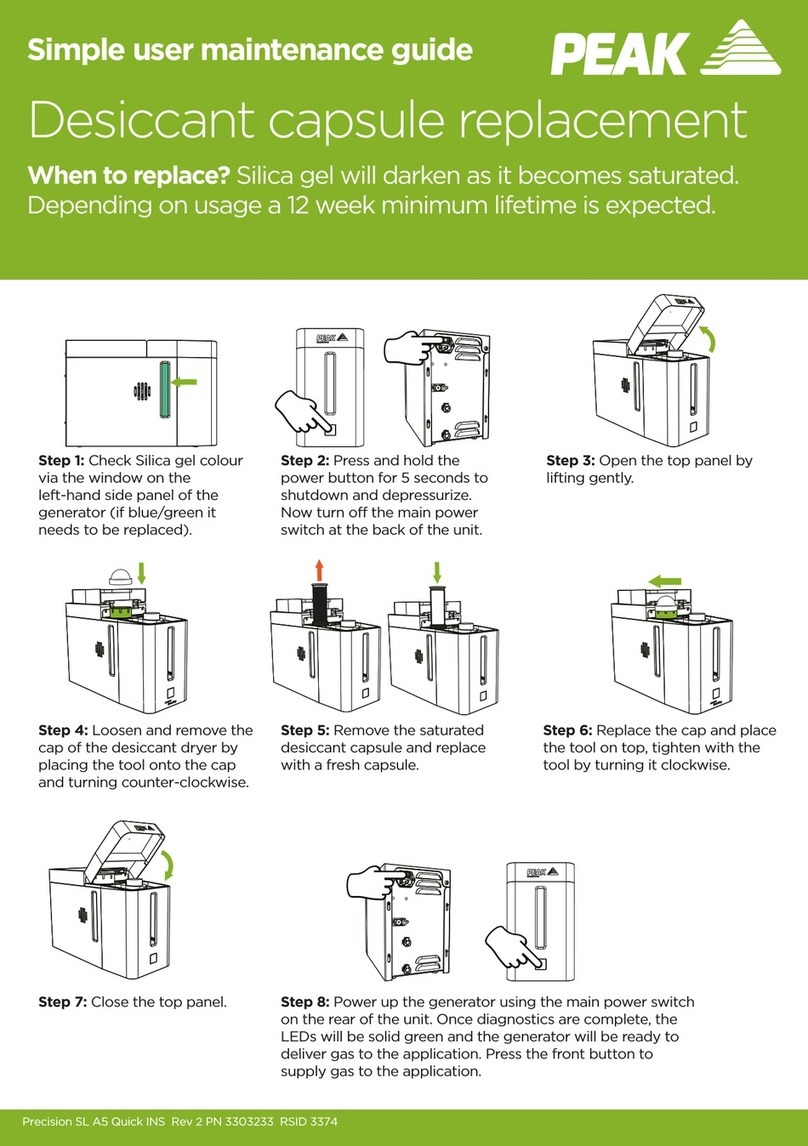
Peak Scientific
Peak Scientific Precision SL A5 User maintenance guide
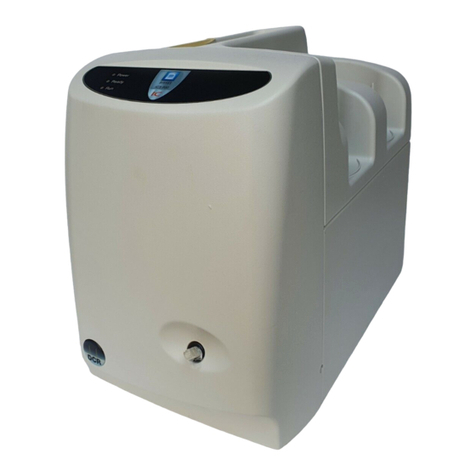
Dionex
Dionex ICS-900 Operator's manual

NoiseKen
NoiseKen LSS-6330-A20A instruction manual
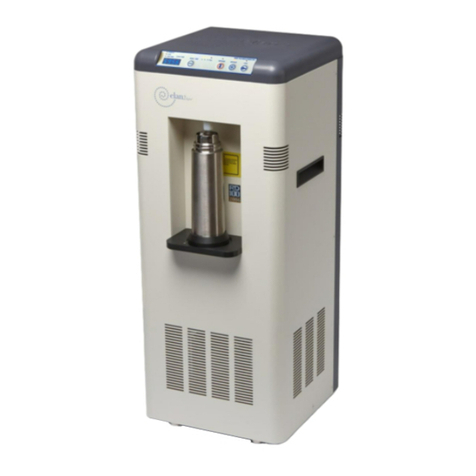
MMR Technologies
MMR Technologies elan2 digital user manual
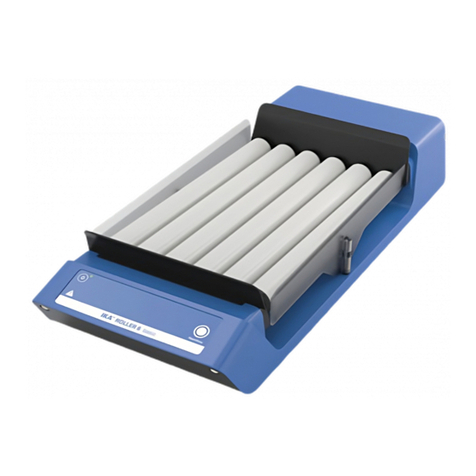
IKA
IKA Roller 6 basic operating instructions

DDS Calorimeters
DDS Calorimeters CAL3K-A installation guide
